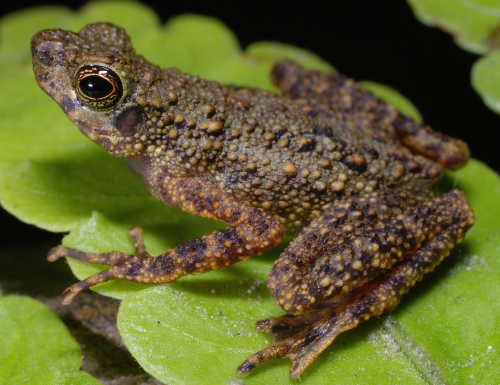| Citation |
|
Description |
Geographic Range [top]
Range Description: This Bornean endemic is known only from a few localities in western and central Sarawak (Malaysia) and scattered areas of Kalimantan (Indonesia), although it probably occurs more widely than current records suggest (Inger et al. 2017). All known localities lie between 200–1,000 m asl.
Countries occurrence:
Native:
Indonesia (Kalimantan); Malaysia (Sarawak)
Additional data:
? Lower elevation limit (metres): 200
? Upper elevation limit (metres): 1000
Range Map: Click here to open the map viewer and explore range.
Population [top]
Population: In Sarawak, it is considered to be common in most localities, such as Gunung Penrissen (Y.M. Pui pers. comm. March 2018). Due to ongoing decline in the extent and quality of habitat, the population is suspected to be decreasing.
Current Population Trend: Decreasing
Additional data:
? Population severely fragmented: No
Habitat and Ecology [top]
Habitat and Ecology: This is a terrestrial species of lowland moist tropical forest, which breeds in small, clear, rocky streams where the larvae also develop. It has not been found in modified habitats.
Systems: Terrestrial; Freshwater
Continuing decline in area, extent and/or quality of habitat: Yes
Movement patterns: Not a Migrant
Use and Trade [top]
Use and Trade: There are no records of this species being utilized.
Threats [top]
Major Threat(s): The principal threat to the species is rapid clear-cutting of lowland tropical rainforest in forest concession land and for oil palm plantations (Indonesia Red List Assessment Workshop May 2017). The subsequent siltation of streams is an additional threat. The area of Gunung Penrissen has a long history of agriculture, especially rice, although rubber and pepper are also grown in all except the steepest terrain (Min et al. 2011). More recently, Gunung Penrissen, has been converted into an 18-hole golf course and a 25 acre area of ‘flower garden and theme parks’), or converted to cultivated land, but there is still some suitable habitat available. The subpopulation from Pelagus National Park occurs in good, intact forest and is not presently threatened (Y.M. Pui pers. comm. March 2018).
Conservation Actions [top]
Conservation Actions: Conservation Actions
This species is known from Gunung Nyuit Nature Reserve, Gunung Bondang Protected Forest, Bukit Baka Bukit Raya National Park, Bukit Batikap Protected Forest, and the Kayan Mentarang protected area. In Sarawak, it is known from Pelagus National Park (Y.M. Pui pers. comm. March 2018). Outside of protected and national park areas, this species is known from conservation areas in forest concessions in Ketapang Regency, West Kalimantan Province (Mediyansyah pers. comm. May 2017). No conservation actions are currently in place for this species.
Conservation Needed
Sustainable management of conservation areas within the forest and oil palm concessions need to be improved and continued (Mediyansyah pers. comm. May 2017). Effective preservation of lowland forest is needed to conserve this species because oil palm plantations are encroaching into protected areas. Some oil palm companies and forestry companies designate High Conservation Value areas, which is required by some financial institutions providing loans. However, not all lenders require these areas to be set aside and the habitat within the HCVs could disappear if the lender or requirements change (Indonesia Red List Assessment Workshop May 2017).
Research Needed
Taxonomic studies is necessary to determine the identity of many specimens assigned to this species (D. Iskandar pers. comm. May 2017). More information is needed on this species distribution and population status.
Citation: IUCN SSC Amphibian Specialist Group. 2018. Ansonia minuta. The IUCN Red List of Threatened Species 2018: e.T54476A114916512. http://dx.doi.org/10.2305/IUCN.UK.2018-1.RLTS.T54476A114916512.en. Downloaded on 09 November 2018.
Disclaimer: To make use of this information, please check the .
Feedback: If you see any errors or have any questions or suggestions on what is shown on this page, please provide us with feedback so that we can correct or extend the information provided
|

